BOUTIQUEResouces
Protein glycosylation is a crucial form of post-translational modification of proteins. It can exert a significant impact on both the physicochemical properties and biological functions of proteins. For biopharmaceutical molecules, glycosylation may determine their clinical efficacy. Therefore, glycosylation is a key quality attribute (KQA) in biopharmaceutical production, which must be closely monitored during the development and manufacturing processes. Additionally, glycosylated molecules need to be specifically isolated or removed in the production process.
In recent years, boronic acid affinity technology has achieved rapid development in the field of glycoprotein purification, and its unique affinity has attracted great attention from researchers. Boronic acid can undergo a controllable and reversible covalent bonding reaction with cis-diol groups, which are widely present in the glycan structures of glycoproteins. Consequently, boronic acid affinity technology is often used as an effective purification method for the selective enrichment and separation of cis-diol-containing compounds. The working principle of boronic acid affinity interaction is shown in the figure below.

The APB affinity resin is an affinity chromatography resin launched by Astrea Bioseparations, with aminophenylboronate (abbreviated as APB) as its ligand. It is particularly suitable for the purification of glycoproteins, or for removing glycoproteins and carbohydrate impurities from non-glycosylated molecules, thereby addressing various challenges in glycoprotein purification processes. In addition, APB resins can also be used to purify and remove certain enzymes, such as proteases and hydrolases for which boronic acid groups have an affinity for their active sites.
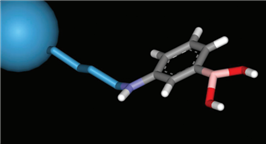
There are two different matrix options available for APB affinity resins. Among them, Aminophenylboronate P6XL is produced using Astrea's proprietary Purabead® P6XL near-monodisperse agarose microspheres to form a highly stable cross-linked agarose matrix. Purabead® products feature an extremely uniform particle size, enabling reproducible chromatography column packing and high flow rates under low backpressure conditions. Therefore, Aminophenylboronate P6XL is the preferred affinity resin for bioprocess applications.
Aminophenylboronate A6XL is an original product of Astrea. The agarose matrix of this resin has a wider particle size distribution, making it more suitable for small-scale or diagnostic applications. Both matrices have been optimized, share the same stable ligand and conjugate, and are suitable for the separation and purification of various biological products.
Product Features of APB Affinity Resin
üSuitable for affinity purification or removal of glycoproteins and glycans
üHigh-purity m-aminophenylboronate ligand
üThe ligand binds selectively to carbohydrate groups via cis-diol groups
üHigh dynamic binding capacity
üExcellent resin stability and long service life
üTolerant to 0.5 M NaOH cleaning, enabling hundreds of cycles of use
üCompliant with ISO 9001 standards, ensuring good batch stability and reproducibility
üProvides comprehensive Regulatory Support Files (RSF) to support GMP production and commercial registration
üAdopted by numerous users in regulated biopharmaceutical manufacturing and medical diagnostic fields
pH Stability
APB affinity resin is stable within the pH range of 3–13 (for continuous exposure) and can withstand intermittent exposure to pH 14.0
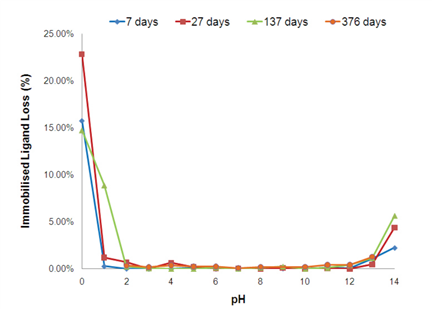
APB A6XL was incubated at room temperature in a series of test solutions ranging from pH 0.0 (1 M HCl) to pH 14.0 (1 M NaOH). Supernatant samples were collected, and ligand leaching was measured at specific time intervals with continuous exposure from 1 week to 1 year.
Flow Rate
The uniform particle size of APB P6XL enables this adsorbent resin to be used at high linear flow rates. An operating flow rate of up to 500 cm/h can be applied, although the flow rate during column loading and elution typically ranges from 50 to 200 cm/h.
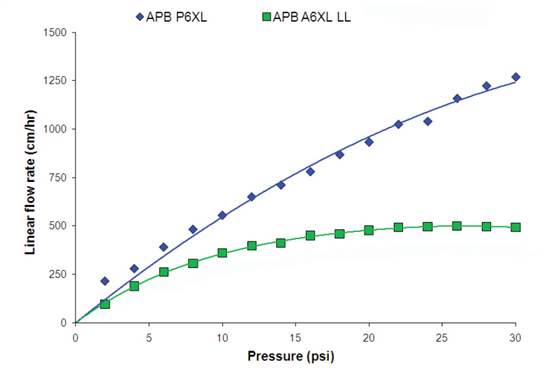
Pressure-Flow Rate Curve of APB P6XL (Diameter: 3.2 cm × Bed Height: 15 cm)
Binding Capacity
The binding capacity of APB P6XL/A6XL for glycoproteins ranges from 10 to 20 μmol/g, and the binding capacity for carbohydrates can be as high as 30 μmol/g.
Operating Conditions
The binding of glycoproteins to APB affinity resins is optimal under low to moderate ionic strength (10–300 mM) and weakly alkaline pH conditions (pH range: 8.0–9.5). Buffers prepared with phosphate can be used, and borate and glycine are recommended for column equilibration. The recommended binding flow rate is between 50 and 150 cm/h. The binding capacity of the adsorbent resin depends on the properties of the sample; for glycoproteins, it typically falls within the range of 10–20 μmol/g.
Bound proteins can be eluted from APB affinity resins either by using a low-pH buffer or a competitive diol. Elution by reducing pH can be achieved using 0.1 M glycine/HCl (pH 4.0) or 0.1 M acetate buffer. For acid-labile proteins, an appropriate competitive diol (e.g., 20–200 mM sorbitol) in a neutral-pH buffer can be used for elution.
APB Affinity Resin Parameters
|
Step |
Condition |
|
Equilibration/Column Packing Buffer |
50 mM Sodium Phosphate Buffer, pH 9.0 |
|
Protein Preparation |
Prepare the protein in equilibration buffer and pre-filter it through a filter with a pore size of ≤0.45 μm. |
|
Operating Flow Rate
|
50-200 cm/h |
|
Elution |
20–200 mM Sorbitol, or 0.1 M Glycine/HCl, or 0.1 M Acetate Buffer, pH 4.0 |
|
CIP |
|
|
Pre-equilibration |
0.5–1.0 M Sodium Hydroxide |
|
Disinfection |
0.5 M NaOH |
|
Storage |
20% Ethanol |
Application Case
1. Purification of Fetuin Using APB P6XL
Fetuin is the major 59 kDa glycoprotein in fetal bovine serum (FBS), containing three N-linked and O-linked carbohydrate side chains. This case describes the purification of fetuin from a commercial crude solution using an APB P6XL chromatography column
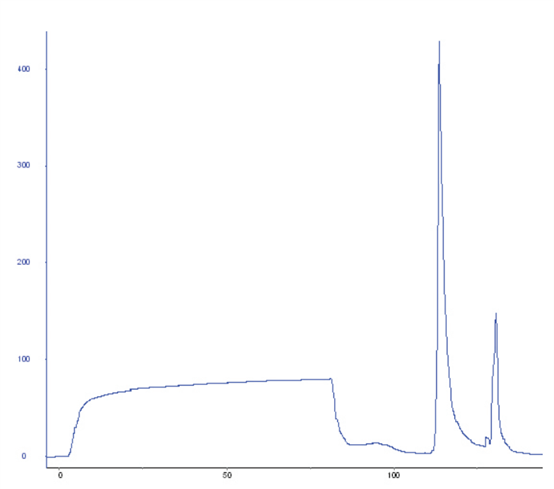
Chromatographic Condition Parameters for Fetuin
· Chromatography Column Height: 4 cm
· Column Volume: 3.1 mL
· Linear Flow Rate: 50 cm/h
· Equilibration & Wash Buffer: 50 mM Sodium Phosphate, pH 9.0
· Elution: Sorbitol Gradient (0–200 mM)
· Disinfection: 1 M NaOH
1. Capture of Recombinant Glycoproteins
APB chromatography resins are particularly suitable for the capture and purification of glycoproteins. The figure below shows a classic affinity purification chromatogram, featuring a large flow-through peak and a small discrete elution peak. Complete recovery of the target glycoprotein is achieved after elution with 50 mM sorbitol.
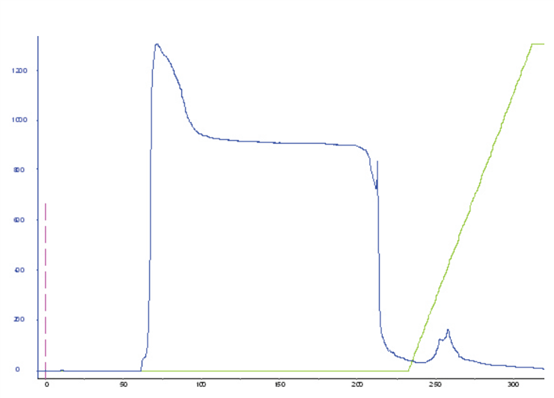
Chromatogram
Chromatographic Condition Parameters:
· Chromatography Column: Diameter 1.0 cm × Bed Height 7.4 cm
· Equilibration & Wash Buffer: 50 mM Glycine/NaOH, pH 9.0
· Elution: 50 mM Phosphate Buffer with 0–200 mM Sorbitol Gradient
· Disinfection: 0.5 M Sodium Hydroxide
· Flow Rate: 200 cm/h
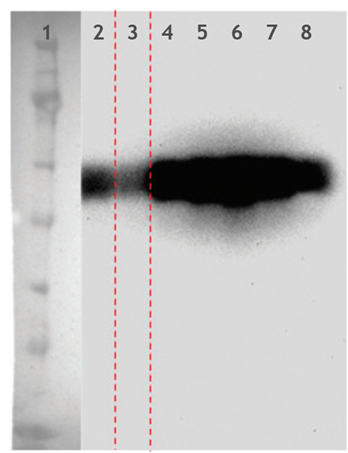
Western Blot Result of Glycoprotein Purified by APB A6XL
(Lane 1: Molecular Weight Marker; Lane 2: Sample Loaded onto APB A6XL; Lane 3: Flow-Through Fraction; Lanes 4–8: Gradient Elution Fractions)
Ordering Information
Aminophenylboronate P6XL
Item Number
Specification
Product Form
3355-00025
25 mL
Bulk Resin
3355-00100
100 mL
3355-00500
500 mL
3355-01000
1 L
3355-05000
5 L
3355-10000
10 L
6716
1 x 1 mL
Prepacked Column
6616
4 x 1 mL
6717
1 x 5 mL
6617
4 x 5 mL
Aminophenylboronate A6XL
Item Number
Specification
Product Form
0355-00025
25 mL
Bulk Resin
0355-00100
100 mL
0355-00500
500 mL
0355-01000
1 L
Astrea Bioseparations
Incorporated in 1987 as a spin-off from the University of Cambridge, Astrea Bioseparations boasts over 30 years of experience in the R&D and manufacturing of chromatography media. It stands as a world-class supplier of chromatography media products and services. To date, more than 21 manufacturing processes utilizing Astrea's products have obtained approvals from the FDA (U.S. Food and Drug Administration) and EMA (European Medicines Agency).
Globally, Astrea Bioseparations operates 3 R&D and manufacturing facilities, focusing on providing industry-leading chromatography media and technical services for the biopharmaceutical (large molecule) and CGT (Cell and Gene Therapy) sectors. The company's innovative nanofiber-based chromatography technology addresses the limitations of traditional bioseparation tools, such as low binding capacity and time-consuming processes. This technology enables faster, more environmentally friendly, and cost-effective purification processes, fully aligning with the evolving needs of today's biotherapeutic innovation.
XMJ (China Distributor)
XMJ serves as the authorized distributor of Astrea Bioseparations in China, offering customers comprehensive technical support and after-sales services. For more information, please feel free to send email to info@xmjsci.com or visit the official website at www.gq44.cn.



.png) 京公網(wǎng)安備 11010802028692號
京公網(wǎng)安備 11010802028692號